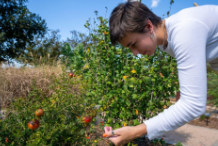K-State horticulture expert says waiting a couple weeks may help cool-season grasses.
September is the best time to give cool-season grasses a boost in Kansas, but with triple-digit temperatures hammering many parts of the state recently, it might be a good idea to hold off just a little bit.
Kansas State University horticulture expert Ward Upham says you can still over-seed such cool-season grasses as tall fescue and Kentucky bluegrass in early September, but it’s going to hit your pocketbook a little harder.
“If it remains really hot, you may be watering three times a day to keep newly-planted seeds moist,” Upham said. “You may want to wait until this current hot spell ends before putting your seed down and starting your watering because then you won’t have to worry quite as much about keeping that soil moist.”
That puts the middle to late part of September as a good time for homeowners to think about thickening up their home’s lawn.
“There are certain steps that are involved, and you should about going through those in order,” Upham said.
Those steps include:
Fertilize the lawn
“We recommend you use a starter fertilizer, which will be higher in phosphorus,” Upham said, noting that fertilizer will give the seed a greater chance of getting started quickly.
Follow the directions on the bag to know how much fertilizer to put down.”
Prepare the soil
Upham said homeowners can use a hand rake to roughen up soil in small areas. For larger areas, he suggests either a verticut machine or core aerator.
“A verticut machine has solid vertical blades that can be set to cut furrows in the soil,” he said. “A slit seeder is a verticut machine with a seed hopper added so the soil prep and seeding operation are combined.”
By contrast, a core aerator literally punches holes in the soil, depositing the cores on the surface of the ground.
“Each hole produces an excellent environment for seed germination and growth,” Upham said. “Make three to four passes with the core aerator to ensure enough holes for the seed.”
A core aerator also reduces the amount of water needed to germinate the seed. Aeration increases the water infiltration rate, decreases compaction and increases the amount of oxygen in the soil.
Apply proper seeding rates
For tall fescue grasses, Upham suggests applying 6 to 8 pounds per 1,000 square feet. Apply three pounds per 1,000 square feet when seeding Kentucky bluegrass, which is a smaller seed. “You’re actually putting down more seed per square foot with Kentucky bluegrass,” Upham said, “but you need that extra seed in order to get a good stand.”
Using too much seed results in a lawn more prone to disease and damage from stress. Using too little seed may result in clumpy turf that is not as visually pleasing. Calculate the yard’s square footage to determine the appropriate amount of seed to apply.
Keep the soil moist
Upham suggests watering newly planted areas lightly, but often. “Keep the soil constantly moist, but not water-logged,” he said. “During hot days, a new lawn may need to be watered three times a day. If watered less, germination may be slowed.”
Cool, calm days may require watering only every couple days, Upham said. As grass plants come up, gradually decrease watering to once a week if there is no rain.
“Let the plants tell you when to water,” Upham said. “If you push the blades down and they don’t spring back up quickly, the lawn needs water. Once seeds sprout, try to minimize foot traffic that seeded areas receive until the seedlings are a little more robust and ready to be mowed. Begin mowing once seedlings reach 3 to 4 inches tall.”
As reported in the High Plains Journal.




